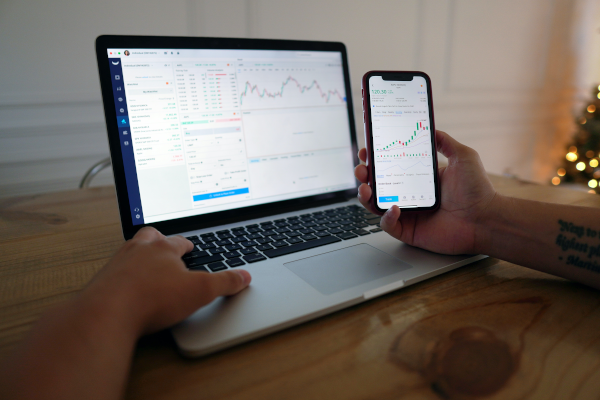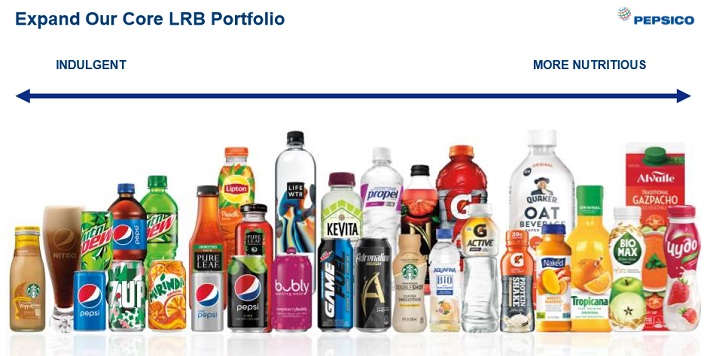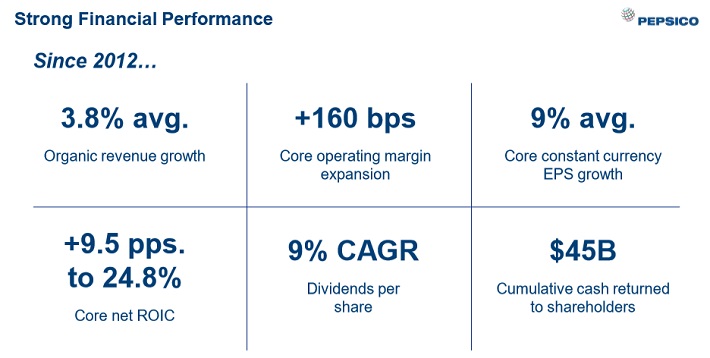Updated on January 21st, 2020 by Bob Ciura
As the saying goes, slow and steady wins the race. This phrase comes to mind when reviewing the Dividend Aristocrats, a select group of 57 companies in the S&P 500 Index, with 25+ consecutive years of dividend increases.
We believe the Dividend Aristocrats are the “cream of the crop” of the U.S. stock market.
You can download your free list of all Dividend Aristocrats by clicking on the link below:
We review all the Dividend Aristocrats each year. Next up, we will review food and beverage behemoth PepsiCo (PEP).
The stock offers a solid 2.7% dividend yield, and has increased its dividend for 47 years in a row. The company’s dividend is very safe and is suitable for risk-averse income investors.
PepsiCo’s valuation is not a screaming bargain right now, but it is rarely a dirt-cheap stock, due to its strong business model and steady growth. The company should have little trouble continuing to raise its dividend for many years.
Business Overview
Pepsi-Cola was created in the late 1890s by Caleb Bradham, a North Carolina pharmacist. Meanwhile, Frito-Lay, Inc. was formed in 1961 from the merger of Frito Company, and the H. W. Lay Company. In its current form, PepsiCo came together as a result of the 1965 merger of Pepsi-Cola and Frito-Lay.
Today, PepsiCo is a global food and beverage giant. It has a market capitalization of $197 billion, and generates more than $63 billion of annual revenue.
PepsiCo’s business is nearly equally split between its food and beverage segments. It is also balanced geographically, between the U.S. and the rest of the world.
PepsiCo has a large portfolio, and owns many popular brands. Some of the company’s major brands include Pepsi and Mountain Dew sodas, as well as non-sparkling beverages like Pure Leaf, Tropicana, Gatorade, and bottled water.
Source: Investor Presentation
In addition to PepsiCo’s core beverage brands, it also has a large snacks business under the Frito-Lay brand. The company has also built a portfolio of healthier foods, including Quaker, Naked, and Sabra.
PepsiCo’s diverse portfolio has served the company well. It has products that cater to all tastes, across the health spectrum.
PepsiCo reported earnings results for the third quarter on 10/3/2019. The company earned $1.56 per share, $0.05 above consensus estimates, but a 2% drop from the previous year. Revenue increased 4.2% year-over-year to $17.2 billion. This was $260 million more than analysts had expected.
Foreign exchange reduced both revenue and earnings-per-share by 1% for the quarter. Excluding foreign exchange, PepsiCo produced organic growth of 4.3% during the quarter, giving the company a year-to-date organic growth of 4.6%. This is well ahead of the 3.4% organic growth that PepsiCo saw through the first three quarters of 2018.
PepsiCo Beverages North America produced 3% organic growth due to higher prices and increased advertisement. PepsiCo has increased its advertising and marketing by 12% so far this year, leading to solid returns among its different product categories. For example, Gatorade results were particularly strong, with mid-single-digit growth and market share gains. In addition, the company’s trademark Pepsi brand posted its fifth quarter in a row of net revenue growth.
Snacks also continued to be a growth driver. Frito-Lay North America grew organic revenue 5.5%. Higher volumes and prices were the main drivers for this division. Quaker Foods improved 1% due to light snacks and Aunt Jemima syrup and mix. PepsiCo continues to expect to earn $5.50 per share in 2019 with organic growth of at least 4%
Growth Prospects
PepsiCo has a long history of steady growth. Even in a challenging environment for soda, PepsiCo has continued its consistent growth. An illustration of the company’s performance from 2012-2018 can be seen in the below image.
Source: Investor Presentation
We believe PepsiCo will generate around 5%-6% adjusted earnings-per-share growth per year over the next five years. Going forward, two of PepsiCo’s most promising catalysts are growth in healthier foods and beverages, and in the emerging markets.
Sales of soda are slowing down in developed markets like the U.S., where soda consumption has steadily declined for years. For example, a recent report states that soft drink consumption in the United States declined in 2018 for the 13th consecutive year. Further, since peaking at 53 gallons in 2000, soda consumption has declined by 25%.
As a result, large soda companies like PepsiCo have had to adapt to a more health-conscious consumer. To do this, PepsiCo has shifted its portfolio toward healthier foods that are resonating more strongly with changing consumer preferences.
In addition, PepsiCo has a huge growth opportunity in emerging markets like China, Africa, India, and Latin America. These are under-developed regions of the world, with large consumer populations and high economic growth rates.
Emerging markets were a growth driver once again last quarter. International markets all saw improved sales results, led by 6% growth in Europe/Sub-Saharan Africa. Latin America was higher by 2% while Asian/Middle East/North Africa grew 5%.
Competitive Advantages & Recession Performance
PepsiCo has numerous competitive advantages. Among them, are strong brands, and global scale. According to Forbes, Pepsi is the #29 most valuable brand in the world, worth an estimated $19 billion. Frito-Lay takes the #40 spot on the list, worth an estimated $14.7 billion.
In all, PepsiCo has 22 individual brands that each collect at least $1 billion in annual revenue. Strong brands give PepsiCo optimal shelf space at retailers, and give the company pricing power.
PepsiCo’s financial strength also allows the company to invest in research and development, as well as advertising, to retain its competitive advantages.
For example, PepsiCo invested nearly $4 billion in R&D from 2011-2017, to innovate new products and packaging designs. In addition, PepsiCo regularly spends more than $2 billion each year on advertising, to maintain market share and build brand equity with consumers.
PepsiCo’s competitive advantages and strong brands allow the company to be highly profitable, even during recessions. Food and beverages always retain a certain level of demand, which is why the company held up so well during the Great Recession.
PepsiCo’s earnings-per-share throughout the Great Recession of 2007-2009 are listed below:
- 2007 earnings-per-share of $3.34
- 2008 earnings-per-share of $3.21 (3.9% decline)
- 2009 earnings-per-share of $3.77 (17% increase)
- 2010 earnings-per-share of $3.91 (3.7% increase)
As you can see, PepsiCo’s earnings-per-share declined only modestly in 2008. The company proceeded to grow earnings by nearly 20% in 2009, which is very impressive. Earnings continued to grow once the recession ended.
Valuation & Expected Returns
PepsiCo is expected to generate earnings-per-share of $5.50 for 2019. Based on this, the stock trades for a price-to-earnings ratio of 25.7. This is significantly above its 10-year average price-to-earnings ratio of 18.7. Our fair value estimate is a price-to-earnings ratio of 18.9. Based on this, the stock appears overvalued. A declining price-to-earnings ratio could reduce annual returns by 6.2% each year over the next five years.
As a result, future returns will likely be comprised of earnings-per-share growth, and dividends. We expect PepsiCo to grow earnings-per-share each year by 5%-6%, consisting of organic revenue growth, acquisitions, modest margin expansion, and share repurchases.
In addition, PepsiCo also has a 2.7% current dividend yield. Still, the overvaluation will be difficult for the stock to overcome. The combination of valuation changes, earnings growth, and dividends results in total expected returns of just 2% per year over the next five years.
PepsiCo has a secure dividend, with a projected dividend payout ratio of 69% for 2019. This gives PepsiCo enough room to continue increasing the dividend at a high-single digit rate each year.
Shares do trade with a premium valuation, but that is likely due to the company’s organic growth. Few other companies in the consumer staples sector can match rate. Even fewer companies can match PepsiCo’s history of dividend growth. PepsiCo is just three years away from achieving Dividend King status. As such, we continue to rate shares as a hold.
Final Thoughts
PepsiCo is a very strong business, with a number of category-leading brands. By investing heavily in new products and acquisitions, it is likely to continue growing sales and earnings for many years.
Shareholders should continue to benefit from PepsiCo’s strong business through annual dividend increases. The stock is overvalued, which means value investors should wait for a more attractive entry point before buying shares.
That said, PepsiCo remains a valuable holding for a dividend growth portfolio.







